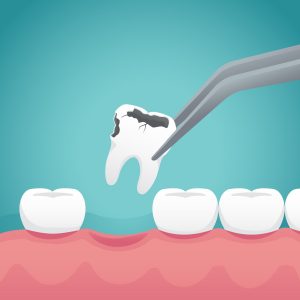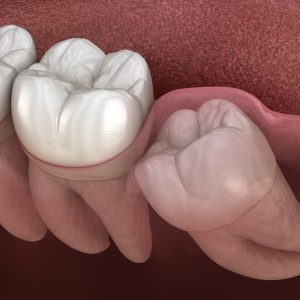Protecting Your Oral Health With Tooth Extraction Services
Have you been experiencing dental issues that require tooth extraction? Whether you’re dealing with impacted wisdom teeth or a damaged regular tooth, understanding the tooth removal process, recovery, and aftercare is essential. In this comprehensive guide, our San Luis Obispo dentists provide you with everything you need to know about tooth extraction services. Learn when and why extraction may be the better option and how you may benefit.
What Is Tooth Extraction?
Tooth extraction is a dental procedure that involves removing a tooth from its socket in the bone. It can be done surgically or non-surgically, depending on the situation. When it comes to tooth extraction services, there are two main types of extractions: surgical and non-surgical.
Surgical vs. Non-Surgical Extractions: What’s the Difference?
The type of extraction you need depends on the location and condition of the tooth, as well as other factors such as your overall health and any medications you may be taking. Here’s what you need to know about the differences between surgical and non-surgical extractions:
Non-Surgical Extractions
Non-surgical extractions are typically performed on teeth that have already erupted from the gum line and can be easily accessed by the dentist or oral surgeon. This type of extraction involves loosening the tooth using a dental instrument called an elevator, and then gently rocking it back and forth until it comes out of the socket. Your San Luis Obispo dentist will use a local anesthetic to numb the area and make the procedure more comfortable.
Non-surgical extractions are commonly used for a variety of reasons, including:
- Decayed or Damaged Teeth: Teeth that have been severely damaged by decay or trauma may not be able to be saved through other means, such as dental fillings or root canals, and may need to be extracted to prevent further damage or infection.
- Teeth That Are Crowded or Causing Alignment Issues: Sometimes, teeth can become overcrowded or misaligned, leading to issues with bite and alignment. In these cases, a non-surgical extraction may be necessary to help create more space in the mouth and prevent further dental problems.
- Baby Teeth That Are Blocking Adult Teeth: When a child’s baby teeth don’t fall out on their own, they can block the adult teeth from erupting properly. A non-surgical extraction can help make room for the adult teeth to come in and prevent alignment issues in the future.
Surgical Extractions
Surgical extractions are typically required for teeth that have not yet erupted or are only partially erupted, and can’t be easily accessed by the dentist or oral surgeon. This type of extraction involves making a small incision in the gum tissue and removing a portion of the bone in order to access the tooth.
Sometimes the tooth may need to be sectioned into smaller pieces to make it easier to remove. Local anesthesia and sedation are typically used to make the procedure more comfortable.
Surgical extractions are commonly used for:
- Impacted wisdom teeth
- Teeth that are broken off at the gum line
- Severely decayed or damaged teeth
- Teeth that have curved or hooked roots
- Teeth that prevent orthodontic treatment
Another important difference between surgical and non-surgical extractions is the type of anesthesia used. Non-surgical extractions usually only require local anesthetic, which numbs the area around the tooth being removed. This allows the patient to remain awake and aware during the procedure, but not feel any pain. On the other hand, surgical extractions may require general anesthesia or sedation, which puts the patient to sleep or into a deep relaxation state.
Benefits of Tooth Extraction Services
Very few people want to lose an adult tooth. However, undergoing a tooth extraction when necessary can be highly beneficial to your oral health. Some of the benefits of tooth extraction services include the following:
- Relief from Pain: Extracting a tooth that’s causing pain or discomfort can provide immediate relief.
- Prevention of Infection: Removing a damaged or decayed tooth can prevent the spread of infection to other teeth and the rest of the body.
- Prevents Crowding: Extracting teeth that are causing overcrowding can help improve alignment and prevent future dental issues.
- Prepares for Orthodontic Treatment: Sometimes, tooth extraction is necessary before orthodontic treatment to create enough space for teeth to shift into proper alignment.
- Improves Oral Hygiene: Removing problematic teeth can make it easier to keep the remaining teeth and gums healthy with regular brushing and flossing.
- Prevents Future Dental Issues: Extracting problematic teeth can help prevent future dental issues and the need for more extensive and costly dental treatments.
Teeth That May Need to Be Removed
Wisdom Teeth
Wisdom teeth are the third molars that typically emerge in the late teens or early twenties. Because they often cause overcrowding and other dental problems, many people choose to have them removed.
Regular Teeth
Regular teeth, or any teeth that aren’t wisdom teeth, may need to be removed if they are severely damaged or decayed, causing infection or pain that can’t be treated with other dental procedures. Your dentist may also recommend removing regular teeth to make room for orthodontic treatment.
The Non-Surgical Tooth Extraction Process
After your standard consultation, your dentist will decide on a surgical or non-surgical extraction. If the tooth isn’t impacted or broken, then your dentist will proceed with a non-surgical extraction.
- Your dentist will start by numbing the area with a local anesthetic to ensure you don’t feel any pain during the procedure.
- Once the area is numb, your dentist will use special tools to gently loosen the tooth from the socket and carefully remove it.
- If the tooth is difficult to remove, your dentist may need to use more force or break it into smaller pieces for easier removal.
- After the tooth is removed, your dentist will place gauze over the socket and ask you to bite down to help stop any bleeding.
The Surgical Tooth Extraction Process
If the tooth is impacted or requires more extensive removal, your dentist may recommend a surgical extraction.
- You will be given a local anesthetic to numb the area and may also be given IV sedation to help you relax during the procedure.
- Your dentist will make a small incision in the gum tissue to access the tooth and bone.
- Next, your dentist will use specialized tools to carefully remove the tooth, which may involve cutting it into smaller pieces.
- Once the tooth is removed, your dentist will stitch the gum tissue back together.
Your dentist will provide you with aftercare instructions and may prescribe pain medication to help manage any discomfort.
Recovery and Aftercare
After the procedure, it’s important to follow your dentist’s or oral surgeon’s instructions for recovery and aftercare. This may include the
- Rest for the first 24 hours and avoid strenuous activity
- Take pain medication as prescribed
- Eat soft foods and avoid hot or spicy foods
- Avoid smoking and using a straw, as these can dislodge the blood clot and delay healing
- Bite down on a piece of gauze for about 30-45 minutes immediately following the extraction to help stop any bleeding.
- Apply an ice pack to the affected area for 10-20 minutes at a time to help reduce swelling and discomfort.
- Brush and floss as usual, but be sure to avoid the extraction site for the first few days to avoid irritation.
It’s important to attend all follow-up appointments with your dentist to ensure proper healing and identify any potential complications.
Frequently Asked Questions
While tooth extraction is generally safe, there are some possible risks involved. These include bleeding, infection, nerve damage, and dry socket. Your dentist will discuss these risks with you before the procedure.
You may need to stick to soft, cool foods for the first day or two after a tooth extraction, but you should be able to gradually resume your normal diet as you feel comfortable. Be sure to avoid using straws or eating hard, crunchy foods that could dislodge the blood clot.
While tooth removal can cause some discomfort, it shouldn’t be a painful experience. Your dentist or oral surgeon will use local anesthesia to numb the area before the procedure, and you may be given pain medication afterward to help manage any discomfort.
Recovery time after a tooth extraction varies but typically takes a few days to a week. To aid in healing, it’s important to follow your dentist’s aftercare instructions, including keeping the area clean and avoiding certain foods and activities. If you experience severe pain, excessive bleeding, or other complications, be sure to contact your dentist immediately.
Call Us To Learn More About Tooth Extraction Services
We strive to help you maintain all of your teeth, but when they just aren’t salvageable, tooth extraction services can protect your smile. Call our San Luis Obispo dental office by dialing (805) 549-8483 to schedule a consultation and learn if tooth extraction services are the solution for you.
You can also request an appointment online by clicking the button below and one of our friendly staff will get back to you shortly. We provide tooth extraction services to patients from San Luis Obispo and surrounding areas such as Santa Margarita, Arroyo Grande, and Pismo Beach, CA.


